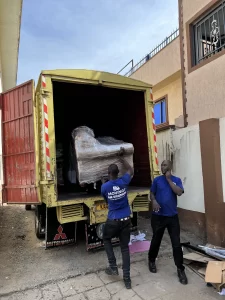Moving internationally, whether by choice or for a job, is a big decision that requires quite a bit of forethought and planning. This goes double when you have pets to bring along. Making the move with pets internationally isn’t nearly as easy as moving with them domestically, nor is it light on stress for human or animal. But if you do your research and plan your move with your pet’s best interests in mind, you should be able to make it a little bit easier on both of you.
Keep in mind: a move with pets internationally is not something that can be planned last minute. Give yourself time to cross your t’s and dot your i’s. It can be a lot to take on in addition to all of the other moving-related planning you inevitably have to get done when you’re relocating internationally, but it’s incredibly important that you take all the necessary steps. After all, your furry one is depending on you to get them to their new home safely. Follow the advice below to make sure you’ve got everything covered.
Closely research the pet import laws in the place that you’re moving
Some countries have stricter pet import rules than others. Regardless of where you’re moving to, it’s crucial that you learn all you can about what your new home country requires in terms of bringing in pets—especially since some countries don’t allow in certain types of animals, or only allow in specific breeds. For the most accurate and up to date information, contact the consulate of the country you’ll be moving to.
Talk to your vet
If you’re going to move with pets internationally, one of your most useful lines of contact will be with your veterinarian. They’ll be able to voice whether they have any concerns about your pet making the long flight (young, senior, anxious, and sick animals are generally not advised to ride in cargo), as well as help you get your pet prepared for travel. This may mean an anti-anxiety medication to calm them during transit or ensuring that they’re up to date on all of their vaccinations. They’ll also be able to help you check off any health requirements dictated by the country you are moving to.
Work with a pet relocation service
If you’re nervous about making the move with pets internationally on your own, there are services that can help. These companies can help you with everything from making sure you follow all the pet import rules of your destination to arranging your pet’s travel itself. They also offer success stories and tips from people who have braved the path before you—an incredibly useful asset when you’re feeling nervous. We at Spacemove Kenya offer pet moving services from and into Kenya
Figure out timing
Like your own visa process, the process for setting up to make the move with pets internationally can be a long one—as long as six months for some countries. If you don’t start early enough, you’ll have to make arrangements for your pet to come to you at a later time; a scenario that’s likely not ideal for either of you. In addition to reading up on what requirements there are, pay close attention to the timeline of steps. You may have to do things at distinct stages, and there may be a waiting period after the steps are done before you can move internationally with your pet without a quarantine period.
Start getting your pet comfortable in their crate as early as possible
If you don’t have an airline travel crate for your pet, get one immediately. And as soon as you have it start the process of acclimating them to it. Not all pets will take to their crates right away, so you need to do what you can to create positive associations with it. The more you can build a strong association for your pet of the crate as a safe place, the better. Encourage your pet to explore the crate by feeding treats and meals in there, and gradually put blankets and a favorite toy in there as well. While crates might seem restrictive to us humans, they can actually be very comforting to your pet—you just might have to put in a little work to get your animal companion to that point.
Call your airline
Even if you haven’t booked your tickets yet, call the airline you intend to travel on and ask about their options and guidelines when it comes to traveling with pets internationally. It’s possible that the airline will have additional rules for travel that the country you’re moving to doesn’t have, and they can also fill you in on specifics regarding crate or carrier size and what you and your pet need to bring along. If your pet is under a certain weight you can also find out about arranging to have them fly in-cabin with you (they’ll stay in their carrier under the seat in front of you).
Get all your documents in order
Make sure you have on hand all documents required of you. This may include documentation of your pet’s rabies vaccine or other vaccinations, a letter from your vet clearing them for travel, or other documentation requirements set out by your airline and the country you’re moving to. Have multiple copies with you, and ensure that everything is signed exactly where it needs to be. Missing or incomplete paper work can mean expensive delays. Worse, it can mean your pet gets denied either before the flight or at customs in your new home.
Flying with a pet other than a cat or dog?
While the advice above is dog and cat specific, it will all apply to other animals as well. However, if you’re moving with a less common pet—such as a bird, reptile, or small critter—be sure that you’re reading specific requirements around that animal when doing your research. Failure to do so could mean missing something critical. Not all countries allow all types of animals, so your very first step is going to be ensuring that your pet is allowed to make the trip. After that, start digging in to the specifics around health requirements, travel requirements, and whether there will be a mandatory quarantine period.
Advanced planning is the key to moving with pets internationally. Start as early as you can, and be thorough so you know you’re not missing anything. Vets, pet relocation companies, and your new country’s consulate and/or embassy are all excellent resources, and you should never be afraid to ask all of your questions (and if you don’t understand an answer—keep asking until you do!).




